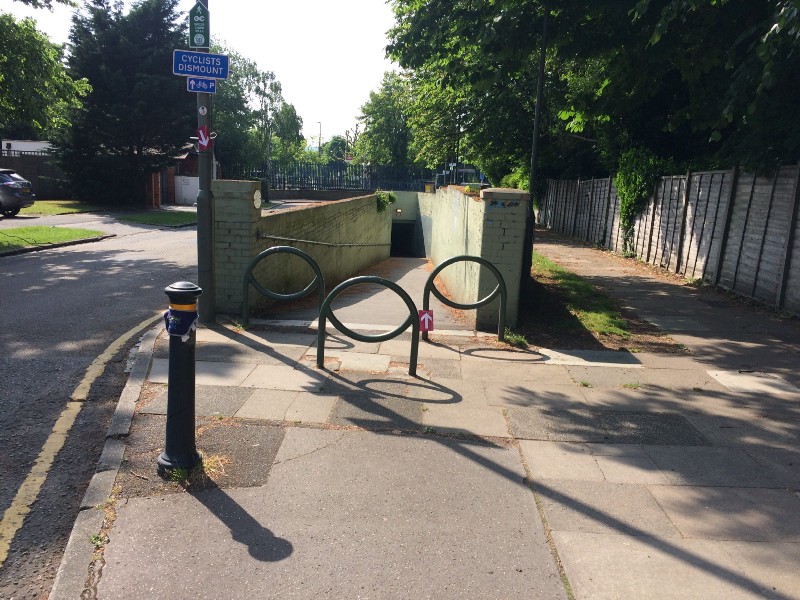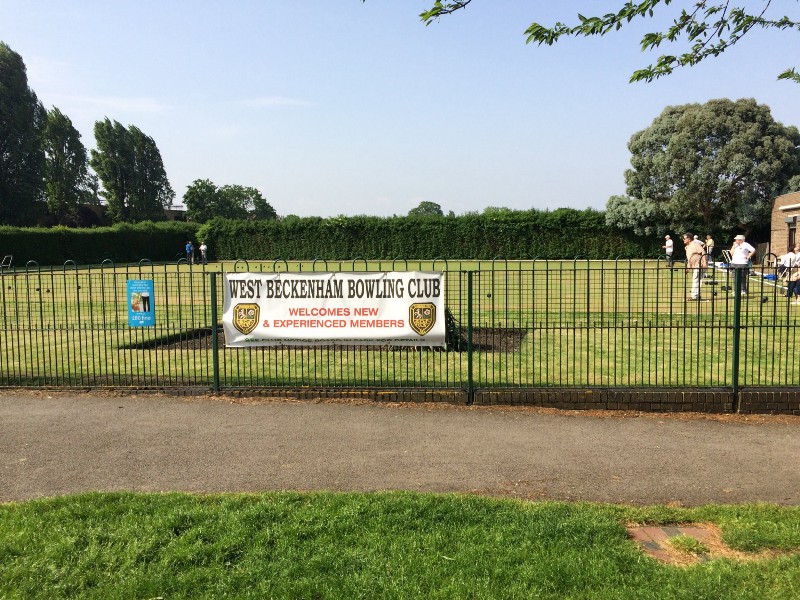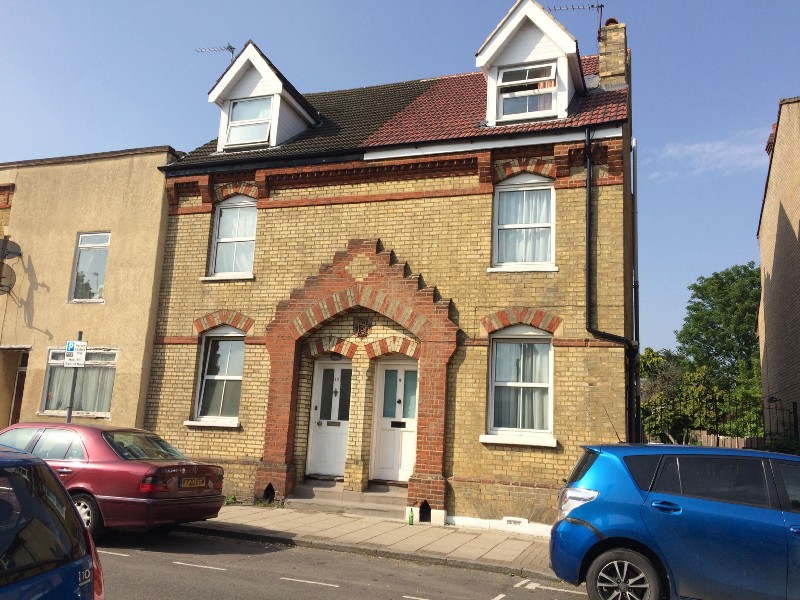Walking round London pt16: Beckenham Place Park to Penge
Pevsner, Larkin, Jimmy Cliff and Status Quo join me on the 120km charitable capital circumnavigation
(ICYMI: on Sat 5 May, the writer walked 36km as the first quarter of a 120km circumnavigation of the capital for charity; on Sat 26 May, he walked the next quarter. These blogs are to publicise the fundraising and consider the vernacular. There’s a full list of chapter/sections at the end of each blog.)
Leaving Beckenham Park behind me and turning left down Beckenham Hill Road — if I’d turned right I’d’ve walked past Sedgehill School, where in 1962 Francis Rossi formed the band that was to become Status Quo — I’m soon stood at the top of Stumps Hill Road, and I spy the Crystal Palace TV tower, two and half miles away across the valley. It’s now a digital transmitter but it’s an analogue for my finishing line: it’s only a kilometre or so from the tape.
Man, that looks a ways away.
First, I dip down Stumps Hill Road, which logically enough ends in Kent County Cricket Club. (Actually, Beckenham Hill was known as Stumps Hill before John Cator turned up to build the mansion and park. The name suggests coppice management, but there’s a fair few tall trees around: oak, ash, field maple, beech, hornbeam and sweet chestnut.) As I take a happy snap of the cricket club’s impressive gates while stood in the middle of the road, a benign bespectacled driver smilingly waits for me.
I’ve never been to Beckenham but I’m enjoying its housing stock. The railway arrived in 1857 and for the following three decades so did the settlers, encouraged by the properties built with care and attention by the Cator family: as one historian puts it, “While some landowners were cramming as many buildings as possible onto their land, Cator was more cautious.”
Beckenham was built in the style of an Indian colonial town, all wide tree-lined avenues and big detached houses in generous gardens. Evidently the Cators were wooing the wealthy, but they also built more affordable properties. I can’t say I’ve seen much of architectural interest, which may be a lack of intelligence or inquisitiveness on my part — but that’s certainly not the same as saying a lack of architectural merit, because I’m not hierarchical like that.
Just a house, but one that’s pleasing on the eye.
So I choose to ignore Nikolaus Pevsner’s unusually strong dismissal — “The churches of Beckenham are a thoroughly pedestrian lot. Even to mention some of them is to give them undue prominence” — and pop into St Paul’s, which the path passes on Brackley Road.
Like Philip Larkin, I often have a look inside churches, which tend to sastify my endless curiosity for examining how people interact with place; unlike that brilliant misanthrope, I don’t have to be “sure there’s nothing going on”. Those who spend their time inside churches — like the chap who’s here now, writing away with pen and paper and asking about the charity walk — tend to be very welcoming people. Once they’ve politely assessed that you’re not suicidal, drunk or particularly likely to contribute to the steeple-repair fund, they tend to leave you to your thoughts, be they spiritual or structural.
Like Larkin, I have no particular architectural expertise — I can often “end much at a loss like this, / Wondering what to look for” — but I can tell you St Paul’s was founded by Albemarle Cator, a descendant of Beckenham Place Park builder John Cator, in 1863 for the growing population and growing with it in 1868. The Second World War wasn’t kind to St Paul’s: a land mine did some damage in 1940 and in 1942 incendiary bombs came through the roof, leaving a still-visible dent in the north aisle and requiring a rebuild in 1949.
And like Larkin, “though I’ve no idea / What this accoutred frowsty barn is worth, / It pleases me to stand in silence here”. Although I must admit I don’t stand: I take the opportunity to sit in a pew and think quietly, enjoying the immense cool air of the centuries.
I emerge rested and restored for the remainder of my journey, and bang on cue a passing car broadcasts Jimmy Cliff singing Many Rivers to Cross: “…but I can’t seem to find my way over; wandering, I am lost.” It’s suitably spiritual and could be seen as allegorical; thankfully I’m on track and my spirits are rising, even as I dip below the railway at New Beckenham — one of the last ‘rivers’ for me to traverse.
The arrows insist: into the hole...
I’m now four-fifths of the way through. Though my soul might soar, my soles are sore so it doesn’t help that I’m going along streets rather than parks with the option of grass for a more forgiving step. I suspect I’ll get my way soon with a park, but will also get hills: they don’t put transmitters in the valley…
…and up the other side.
Indeed, soon I’m on Cator Park — that name again. This was originally the Kent House Pleasure Gardens for Cator Estate residents — told you they were thoughtful — and became public-access in the 1930s, as so many of London’s parks did.
As the walk winds its way through it, curving round the back of a Montessori school at what is the southern apogee of the entire Capital Ring, I’m thinking to myself that the park is nothing special. I quite like the way they’ve made a felled trees into a seating area, but otherwise it’s nothing unusual.
Cator glade.
However, it suddenly strikes me that we’re very lucky that we have so many parks available to us, thanks to various means: property speculators creating pleasure gardens, industrialists turning over sandpits to the greater good, estate designers carefully preserving ancient woodlands. I might not cross London to get to a local park like this, but if I lived near here I’d be very glad of it. It doesn’t have to be a tourist destination, it just has to be somewhere for the people to come, and they have: sunbathing, gently cycling, enjoying the time and the place.
A playful colonnade of conifers at Cator Park.
However long it’s been open, people will have had formative experiences on Cator Park, they’ll have fallen in love on Cator Park, they’ll have proposed marriage on Cator Park, they may have got married on Cator Park, they may have even cheekily procreated on Cator Park, they may have pushed their kids round Cator Park, they may have fallen out of love on Cator Park — or they may just come to Cator Park now and again when it’s a nice day and there’s nothing on the telly. And that’s enough. Which I suppose isn’t too dissimilar to Larkin “reflect[ing] that the place was not worth stopping for” before thinking more deeply about the nature of churches. We’re lucky to have the parks that we do.
As I climb up Lennard Road — which the locals used to know as Hospital Road, for the very good reason that it led to the Bromley and Beckenham Joint Hospital For Infectious Diseases — I spy my end-goal again, winking at me from atop the hill. Coming to getcha, tower.
A right and a left and as I go up a narrow path caught between two schools, a byway whereupon the riding of “bicycles, tricycles and other similar machines” might earn you a five-pound fine, I pass the 30k mark. I’m in the last 5k now, which feels good: six-sevenths of the way there. These things matter. I mark the occasion with a celebratory Go Ahead yoghurt bar and proceed indeed to go ahead.
After walking along Cator Road past Woodbastwick Road — named after the Cators’ family seat in Norfolk — I’m on yet another park. Commemorating the wife of King Edward VII (reigned 1901–10, hence “Edwardian”; Victoria’s eldest, the longest heir apparent before Charles nicked that crown, at least), the Alexandra Recreation Ground is sleepy in the 4.30pm sunshine: some lads listlessly boot a ball vaguely towards each other.
Alexandra Recreation Ground: not oversubscribed.
Sleep can be metaphorical or literal. Behind me as I take a picture of West Beckenham Bowling Club (with its giggleworthy sign “welcomes new & experienced members”), a man with one shoe sleeps on a park bench which may or may not be his forwarding address.
Spat out of Alexandra’s far end, I’m back on Lennard Road, named after Lennard Pearce, the RADA-trained actor Royal Shakespeare Company actor who met Hitler, worked with Olivier, acted in Cathy Come Home and Dixon of Dock Green but will forever be best remembered for being Grandad in the first 23 episodes of Only Fools and Horses. No, sadly, that’s not true — it’s named after a mate of the Cators who had been chairman of the Board of Guardians at the Farnborough workhouse. But I prefer the Grandad story.
What do you mean, “avoiding steps”?
A more interesting nominative origin is Penge — such a comedy concept that even Pevsner described it as “for most people a joke, an epitome of a dreary suburban non-place. It is a reputation not quite deserved,” said the owlish architecture buff. The name is intriguing in that it comes from the Celtic from “edge of the wood”; it’s one of the few Celtic placenames in the capital, indicating a native British presence — or at least influence — after the Angles and Saxons came to town.
In fact, there’s an Anglo-Saxon royal connection to Penge, although it’s not as romantic as that might sound. In 957, King Eadwig — who got the big job at 15 when his uncle Eadred died, and lasted not wuite four years before hopping the twig himself — granted his mate Lyfing the manor of Battersea, and threw in a swine pasture at Penge; for this reason, Penge was in the parish of Battersea right up until 1899.
None of this is on my mind as the path takes me over the tracks at Penge East station (yellow London stock brick with accents of red and blue), but Pevsner said “a journey from the Crystal Palace down the hill to the High Street and beyond yields several buildings worth a look.” That’s not the direction I’m travelling in but my eye is soon caught by a couple of interesting places. On Station Road there’s a semi-detached house with enormous elaborate brickwork over the double doors. Who went to such effort, and why? I may never know.
And opposite that, on Mosslea Road, a church which has obviously seen better days but is still hosting worship. It’s now the Catholic church of the Good Shepherd, but the large inscription “Holy Trinity” suggests it was a mission hall for the Church of England Holy Trinity, Beckenham. There are more questions than answers, and not enough time to even start. It’s time to hit the High Street, climb the hill and go into Crystal Palace Park.
Coming up next: Crystal Palace Park. I’ve just told you that.
The Mencap Capital Challenge is a charity walk circling London in four quarters, each roughly 30km. You can donate or sponsor the writer at justgiving.com/garyparkinson1974. You can also join in: the South quarter (Crystal Palace to Richmond) will take place on Sat 9 June, the West quarter (Richmond to Hendon) on Sat 7 July.
NORTHERN QUARTER, SAT 5 MAY 2018
• Pt1: Wembley to East Finchley • Pt2: …to Finsbury Park
• Pt3: …to Clissold Park • Pt4: …to Springfield Park
• Pt5: …to Hackney Wick • Pt6: …to Bow Back River
• Pt7: …to Channelsea River • Pt8: …to Royal Victoria Dock
EASTERN QUARTER, SAT 26 MAY 2018
• Pt9: Victoria Dock to North Woolwich Pier • Pt10: …to Maryon Park
• Pt11: …to Hornfair Park • Pt12: …to Oxleas Wood
• Pt13: …to Eltham Palace • Pt14: …to Grove Park
• Pt15: …to Beckenham Place Park • Pt16: …to Penge
• Pt17: …to Crystal Palace Park • Pt18: …to Upper Norwood
SOUTHERN QUARTER, SAT 9 JUN 2018
• Pt19: Crystal Palace to Beulah Hill • Pt20: …to Streatham Common
• Pt21: …to Tooting Bec • Pt22: …to Wandsworth Common
• Pt23: …to Wimbledon Park • Pt24: …to Richmond Bridge
WESTERN QUARTER, SAT 7 JUL 2018
• Pt25: Richmond Bridge to Isleworth • Pt26: …to Hanwell Locks
• Pt27: …to Horsenden Hill • Pt28: …to Sudbury Hill
• Pt29: …to Wembley, and that's that




















